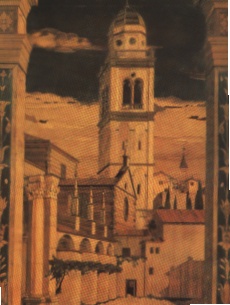
Santa Maria in Organo
Encyclopedia

Verona
Verona ; German Bern, Dietrichsbern or Welschbern) is a city in the Veneto, northern Italy, with approx. 265,000 inhabitants and one of the seven chef-lieus of the region. It is the second largest city municipality in the region and the third of North-Eastern Italy. The metropolitan area of Verona...
, Northern Italy
Northern Italy
Northern Italy is a wide cultural, historical and geographical definition, without any administrative usage, used to indicate the northern part of the Italian state, also referred as Settentrione or Alta Italia...
.
History
The church's origin dates to the 6th-8th century, at the time of the OstrogothOstrogoth
The Ostrogoths were a branch of the Goths , a Germanic tribe who developed a vast empire north of the Black Sea in the 3rd century AD and, in the late 5th century, under Theodoric the Great, established a Kingdom in Italy....
and Lombard
Lombards
The Lombards , also referred to as Longobards, were a Germanic tribe of Scandinavian origin, who from 568 to 774 ruled a Kingdom in Italy...
dominations in Italy. The original convent was destroyed in Napoleonic
Napoleonic Wars
The Napoleonic Wars were a series of wars declared against Napoleon's French Empire by opposing coalitions that ran from 1803 to 1815. As a continuation of the wars sparked by the French Revolution of 1789, they revolutionised European armies and played out on an unprecedented scale, mainly due to...
times. The church was rebuilt after an earthquake in 1117. It once faced a branch of the Adige River, now grounded.
From the 14th century it was a parish depending from the Patriarchate of Aquileia, to which it belonged until its dissolution in 1756. In 1444 it was sold the Olivetan Benedictins
Olivetans
The Olivetans, or the Order of Our Lady of Mount Olivet, are a monastic order formally recognised in 1344. They have formed the Olivetan Congregation within the Benedictine Confederation since 1960.-History:...
, who held it until 1808. The monk Giovanni da Verona executed the tarsia
Tarsia
Tarsia is a town and comune in the province of Cosenza in the Calabria region of southern Italy. The ancient town of Caprasia is thought to be the modern Tarsia....
s of the wooden choir, and designed the bell tower, finished in 1533.
Starting from 1547 a Romanesque-Gothic façade, in white marble, was begun, designed by Michele Sanmicheli; this has remained unfinished. Among the other possessions, the Abbey held the church of Santa Maria Maggiore of Gazzo Veronese
Gazzo Veronese
Gazzo Veronese is a comune in the Province of Verona in the Italian region Veneto, located about 100 km southwest of Venice and about 30 km south of Verona....
.
Interior
The interior is on the Latin cross plan, with a nave and two aisles. It houses a rich collection of paintings, with works by Girolamo SavoldoGirolamo Savoldo
Girolamo Savoldo, also called Girolamo da Brescia was an Italian High Renaissance painter.-Biography:...
, Domenico Morone
Domenico Morone
Domenico Morone was an Italian painter from Verona, painting in an early Renaissance style.Domenico Morone is known from a few panels, mainly depicting public festivals or tournaments, in which the figures in the crowds are small...
, Francesco Morone
Francesco Morone
thumb|280px|Samson and Delilah. Milan, [[Museo Poldi Pezzoli]].Francesco Morone was an Italian painter, active in his native city of Verona in a Renaissance style. He was the son of the Veronese painter Domenico Morone. The art biographer Vasari praised his frescoes for the cupola of the sacristy...
, Antonio Balestra
Antonio Balestra
Antonio Balestra was an Italian painter of the Rococo period.Born in Verona, he first apprenticed there with Giovanni Zeffio. By 1690 he moved to Venice, where he worked for three years under Antonio Bellucci, then moved to Bologna and then to paint in Carlo Maratta's workshop in Rome. In 1694, he...
and Guercino among the others.
Under the presbytery is the crypt, a relic of the High Middle Ages edifice. It has maintained the 8th century capitals of the columns. It has works by Luca Giordano
Luca Giordano
Luca Giordano was an Italian late Baroque painter and printmaker in etching. Fluent and decorative, he worked successfully in Naples and Rome, Florence and Venice, before spending a decade in Spain....
, Francesco Morone and Antonio Balestra, along with the popular Muletta, a wooden sculpture from the 14th century, which depicts Jesus entering Jerusalem riding a mule.

